Rocking the boat with a click of a mouse: Women on Waves and Women on Web
Any vessel that has tread the high seas has been tossed by the waves and the winds, but not as much as Women on Waves. The nearer it came to its harbour of destination, the more the vessel was rocked with protests from anti-abortion advocates, especially the religious. Despite its limited voyage, Women on Waves has certainly rocked countries where abortion is not available. By picking up women from these countries and performing abortion procedures on international waters, it demonstrated ingenuity in sidestepping restrictive national laws which deny millions of women their fundamental rights to health and life. 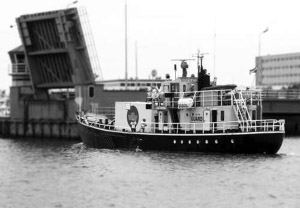
But Women on Waves’ ferocious desire to respond to women in need of abortion has not only emboldened it in the high seas. It went beyond the boundaries by tapping the internet and working with Women on Web. Aside from facilitating abortion in countries where the procedure is illegal, Women on Web has been an effective recourse during the years when the group was prevented from operating beyond 25 miles from the Dutch landmass.
The website of Women on Waves provides materials on its campaign. It also features rich information on abortion, pregnancy, and sexually-transmitted disease, among others. Meanwhile, Women on Web serves as an extension of Women on Waves’ direct support service, offering medical consultation and facilitating access to safe abortion.
The beginnings of the journey
Women on Waves advocates safe and legal abortion, which could save the lives of thousands of women worldwide. The World Health Organisation estimates that annually, 70,000 deaths occur out of the 20 million induced abortions done in unsafe conditions annually. Based on this number, Women on Waves calculates that a woman dies every six minutes, usually in developing countries where access to abortion is severely restricted.
Women on Waves is the brainchild of Rebecca Gomperts, a Dutch physician who served as a doctor for the crew of Greenpeace’s Rainbow Warrior. Inspired by the plight of an 18 year-old Latin American woman who lost her mother to backstreet abortion and had to look after three younger siblings, Gomperts, together with a few other women, hatched the idea of raising funds to rent a fishing vessel and perform abortion procedures and related services in international waters where the Dutch crew and local patients may evade national laws.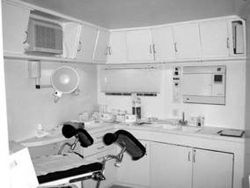
The project further squeezed the creative juices from Gomperts and her associates. The group used a container van which houses the clinic, vital equipment, and stocks of medicines. Women on Waves made its maiden voyage outside Netherlands in 2001 with Ireland as its destination. Ireland allows abortion only when the pregnancy puts the mother’s life at risk.
As expected, the fishing boat Aurora was met with condemnation by pro-life groups. Worse, the Dutch government released an order, prohibiting the group to serve abortion pills when the vessel was already en route to Dublin. Similar hassles accompanied the group when it sailed to Poland and Portugal in 2003 and 2004, respectively. Among these three overseas journeys, the most controversial and the most successful had been Portugal. As the vessel neared national waters, two warships formed a blockade as Portugal’s Defense Secretary deemed the fishing vessel a threat to “public health” and “social peace.”
“That experience is extremely productive. There has been an enormous development ever since and in that sense, we learned a lot [with the naval blockade],” Gomperts recounted.
This naval confrontation sparked a heated debate at the European Union and a backlash against the Portuguese government. While Women on Waves was not able to conveniently perform its mission, the event drew significant media attention that made abortion a priority agenda in policy-making. Following the victory of the Labour Party in the last elections, a referendum was called and eventually a new law was passed, legalising abortion until the 10th week of pregnancy.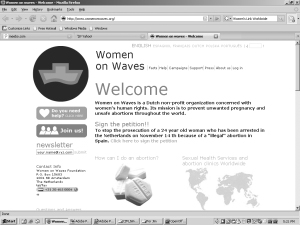
A back up on the web
Portugal was the last overseas destination of Women on Waves, before a conservative Dutch administration restricted its operations within national boundaries. With this legal constraint affecting its mobility, Women on Waves turned to the internet. “This has filled the gap during those times and created awareness among women, who have been encouraged to ask questions especially on Misoprostol, over the internet. And this has been going on quite well,” Gomperts described.
A good part of its first web pages of Women on Waves’ website is devoted to abortion drugs such as Mifepristone and Misoprostol. When taken by women who are less than nine weeks pregnant, this combination is said to have more than 97 per cent success rate. Using Misoprostol alone, according to doctors, has a success rate of more than 80 per cent. Misoprostol is the agent that makes the womb contract and expel the fetus, causing cramps and bleeding. Meanwhile, Mifepristone discontinues the effects of progesterone, the hormone that supports gestation.
The website enumerates and explains several precautions in taking the drug and undergoing abortion in very clear language and in a manner that seems to anticipate the reader’s next questions. For example, it provides advice to women who may be interested to use Misoprostol but who also have ectopic pregnancies or intra-uterine devices. It also explains the implications if Misoprostol fails to work in the first few attempts: “When Misoprostol did not cause any bleeding at all, there is a small increased risk of birth defects such as deformities of the hands or feet and problems with the nerves of the fetus, if the pregnancy continues. Because of this low risk of birth defects, a vacuum aspiration should be done.”
Using the same principle of evasion applied by Women on Waves when doctors performed operations in international waters, Women on Web uses the internet to facilitate access to these drugs for women living in countries which prohibit abortion.
Because the use of Mifepristone and Misoprostol may be the safest way to induce abortion, these drugs constituted the bulk of the medicines in Women on Waves’ container-van-turned-clinic. While these drugs are available, sometimes over-the-counter in several parts of Europe, they are restricted, if not unavailable, in the developing world where most backstreet abortions occur.
Using the same principle of evasion applied by Women on Waves when doctors perfor med operations in international waters, Women on Web uses the internet to facilitate access to these drugs by women living in countries which prohibit abortion.
Women on Web is separate from Women on Waves, but this online community consisting of advocates of reproductive rights and people, including couples who decided for abortion, is closely linked with Gomperts and other individuals involved in the campaign at sea. The website of Women on Web may be divided into two parts. One part features an online consultation service or “I need an abortion” and a freedom wall, where women are encouraged to come out of the closet and share their experiences in deciding to terminate their pregnancies or “I had an abortion.”
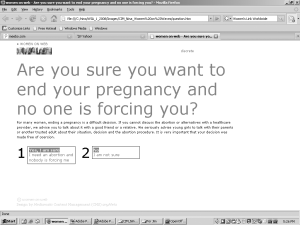 Visiting the online clinic
Visiting the online clinic
Pretending to be less than nine weeks pregnant, I tried accessing the appropriate medications to get a safe abortion. Using the external link to Women on Web, the first web page immediately provided an option of toning down the graphical user interface of the web page and the succeeding ones. This made the consultation more discreet, particularly for patients using public internet kiosks. Once this option is selected, the colours disappear and one is walked through the same process, though questions and explanations would seem to be printed in economy mode.
One is not immediately referred to a doctor on the other line as the following conditions must first be met: the patient must be living in a country where abortion is illegal; must be heavy for less than nine weeks; and must not have any serious illness. Patients are also advised to first confirm their pregnancy using ultrasound technolog y. If this technology is unavailable in the countries where patients seek online assistance, then the consultation process stops at the third or fourth click. The consultation would also be discontinued if one is already more than nine weeks pregnant and the patient is redirected to a web page that containing a list of abortion clinics worldwide.
The initial consultation consists of 25 questions, beginning with the more basic like one’s certainty in undergoing the procedure; the number of weeks one has been pregnant; the confirmation of pregnancy via ultrasound technology; the distance of one’s home to the hospital; the presence of a partner or a relative who can stay with the patient through the process. Other questions deal with one’s medical history like allergies, heart disease, epilepsy, hypertension, diabetes, liver disease, among others.
When I reached the seventh web page, I was told more about Misoprostol and its effects on women who are more than seven to 11 weeks pregnant. In Europe, Misoprostol is not officially registered for pregnancies beyond seven weeks but in practice, the drug has been proven safe and effective until the ninth week. The site further explained: “This only means the doctor must inform you that it is not officially registered for pregnancies after seven weeks. Medical abortions done between seven and 11 weeks have a slightly higher risk of complications than abortions performed before seven weeks of pregnancy. For pregnancies from seven to nine weeks, 0.2 per cent of the women might need emergency treatment for heavy bleeding.”
I was also given an idea of how many more questions I would still have to answer with the row of boxes on top. For every question that a patient answers, a photo fills the box. These are photos of people who experienced abortion. After less than 15 minutes of answering 25 questions, I was given the following prescription: one 200 mg tablet of Mifepristone; six (200 mg) of Misoprostol; and a pregnancy test kit. The medicines and the kit would be mailed to me in a packet.
In return, I was asked to make a donation of 70 Euros either through credit card or bank transfer. In case I did not have that amount, Women on Web would find a sponsor who could partially subsidise the amount.
This convenient system has been serving a multitude of women, mostly from the developing South since 2004. According to Gomperts, Women on Web usually registers 80,000 unique visitors every month or almost a million each year. About ten per cent of the women who availed of the packets were partially subsidised.
Women on Web also features a freedom wall containing photos and stories of women who underwent abortion.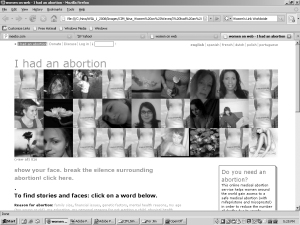 While this cannot be a substitute for counseling, it has the potential of comforting women who have yet to make the decision or have already terminated their pregnancies. The organisation of profiles is also ingenious. They are categorised according to reasons for the abortion; the manner in which the abortion was performed; countries where the procedure was done; the religion of the patients; and the feelings of the patients about their experience, among others. These help the prospective patient select stories which come from a context that is similar to hers, thereby enabling her to understand her present emotions, especially of guilt, and visualise future scenarios. Conversely, Women on Web encourages those who have had abortion to share their stories, and if possible, photos, by filling up a fact sheet.
While this cannot be a substitute for counseling, it has the potential of comforting women who have yet to make the decision or have already terminated their pregnancies. The organisation of profiles is also ingenious. They are categorised according to reasons for the abortion; the manner in which the abortion was performed; countries where the procedure was done; the religion of the patients; and the feelings of the patients about their experience, among others. These help the prospective patient select stories which come from a context that is similar to hers, thereby enabling her to understand her present emotions, especially of guilt, and visualise future scenarios. Conversely, Women on Web encourages those who have had abortion to share their stories, and if possible, photos, by filling up a fact sheet.
Women on Web also hosts fora, which allow the discussion of various issues surrounding reproductive rights, especially abortion. These include abortion methods; developments within Europe; the legal status of abortion in Latin American countries like Nicaragua and El Salvador; unsafe abortion in Asia and Africa; attempts of watering down Roe v Wade in some parts of the United States; and the relationship between religion and abortion.
Yet a more challenging voyage
With the recent assumption to office of a socialist party in the Netherlands, Women on Waves has been granted license to set sail again on international waters. Gomperts confirmed that she has been setting her eyes on Latin America and the global South. But learnings from the previous journeys of her group are obviously at the back of her mind. Asked where the next destination would be, “We are preparing for next campaign but it is a secret. We don’t want to be blocked again,” she said.
Recently, Women on Waves conducted an infor mation drive, using “info stickers” which explained Misoprostol and other details on medical abortion. These stickers reached Africa and other countries through the group’s partnership with other like-minded organisations. “These info stickers were meant to be seen in public places including comfort rooms to spread the knowledge about medical abortion as widely as possible,” Gomperts explained.
 The creativity and ingenuity of Gomperts and her associates have indeed amplified the opinion of women and science such that they have created a momentum on local and regional policy processes. They have also provided a refuge to many women who often carry the responsibility of reproductive health on their own, including the guilt that is commonly associated with abortion.
The creativity and ingenuity of Gomperts and her associates have indeed amplified the opinion of women and science such that they have created a momentum on local and regional policy processes. They have also provided a refuge to many women who often carry the responsibility of reproductive health on their own, including the guilt that is commonly associated with abortion.
The experiences of Women on Waves and Women on Web are instructive. However, offering abortion service on international waters or online is not sustainable. Only educated and high- income women from the developing world would most likely have access to computers and the internet, and relevant websites such as Women on Web.
Legalising abortion in different countries remains the key in preventing unwanted pregnancies and the unnecessary loss of women’s lives. Until such structural barriers are washed away and significant changes are implemented on the ground, many more lives will remain floating in uncertainty and in silence.
Other references:
Charter, David (2008). “Offshore abortion women’s group given license again.” Retrieved from Times Online on 1 April 2008 http://women.timesonline.co.uk/tol/life_and_style/women/article1701326.ece
de Queiroz, Mario (September 10, 2003). “‘Abortion ship’ heads back home after stand-off with Portugal.” Retrieved from Inter Press Service on 1 April 2008 http://ipsnews.net/news.asp?idnews=25431
Ferry, Julie (2007). “The abortion ship’s doctor.” Retrieved from The Guardian on 1 April 2008 http://www.guardian.co.uk/world/2007/nov/14/gender.uk
Gerstel, Judy (January 25, 2008). “Floating clinis spreads word on abortion pill.” Retrieved from The Star on 1 April 2008 http://www.thestar.com/living/Health/article/297216
Murphy, Clare (July 1, 2003). “Abortion ship makes waves in Poland.” Retrieved from British Broadcasting Corporation on 1 April 2008 http://news.bbc.co.uk/2/hi/europe/3035540.stm
Obando, Ana Elena (2005). “An interview with Rebecca Gomperts from Women on Waves.” Retrieved from Women’s Human Rights Net on 1 April 2008 http://www.whrnet.org/docs/interview-rebecca-0512.htm





 The
The 
 Isis Resource Center holds one of the largest feminist collections of materials in the Global South. With 40 years of publication experience, Isis holds a vast collection.
Isis Resource Center holds one of the largest feminist collections of materials in the Global South. With 40 years of publication experience, Isis holds a vast collection.